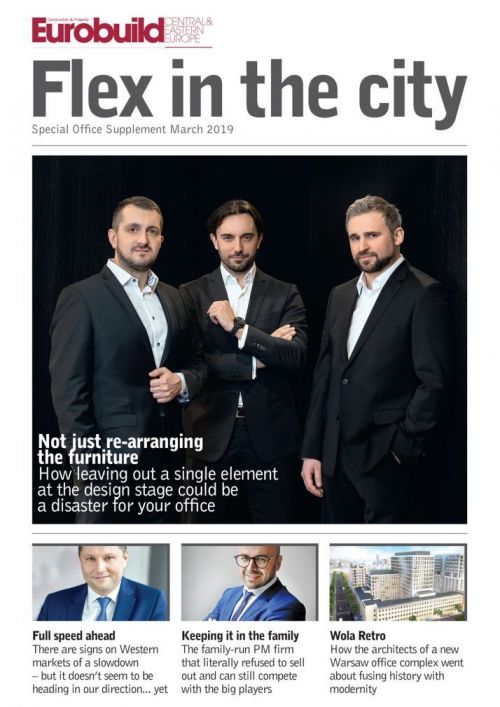Full speed ahead
Trends
Alexander Hayes, ‘Eurobuild Central & Eastern Europe’: Supply is up, vacancy is down and yields are being squeezed. How long can this last?
Tomasz Czuba, Head of Office Leasing, JLL Poland: (laughs) If I knew the exact answer I’d probably be buying a lottery ticket. I don’t think there’s going to be too much change in the near future. The market’s performance is still very good. Even such Warsaw districts like Mokotów, which in terms of office space is the biggest district outside the city centre, is starting to attract investors’ attention. I don’t believe this district will remain the ugly duckling. In fact, I think that in the next 12–18 months Mokotów will see new office investment transactions. As for the entire market we aren’t seeing any signs of a slowdown. A good example of the projects we represent is the Warsaw Hub by Ghelamco, where we pretty much have enough interest for all of the Hub’s space. Of course, interest doesn’t always mean deals. But regarding other developers, they’re not complaining either. From a landlord’s perspective it’s a very good time to lease space, but this window of opportunity will close when a number of new developments are delivered between 2020 and 2022. If you remember when Warsaw Spire was under construction, people were saying it’s crazy to build 100,000 sqm of office space in one go. But now it’s a landmark project of the Wola district. Later on we had projects like Business Garden – 50,000 sqm outside the city centre, which is now almost fully leased. So I don’t believe that the market will face any kind of crisis in the nearest future. All of the tenants that we know are talking about expanding rather than contracting. So the office market isn’t slowing down. Not yet.
What does not yet mean? Not for a year? Not for two?
I don’t have a clear answer. On the one hand, we can see that the economy is slowing down in Germany and Western Europe, but the BPO/SSC companies are booming here in Poland. They are looking for new projects and for new space as well. We also have a pipeline of companies that are considering setting up new businesses here. So my gut feeling is that even though we can see a slowdown in Western Europe, this may have little effect in Poland, or on the contrary – it may even in fact even be a business opportunity for us. Indeed this is what we saw during the crisis of 2008/2009.
My understanding of the BPO sector is that they very much like low costs and Poland can no longer be counted as a low cost labour market?
The companies which are responsible for simple business operations do rely on low cost business. But we have to be aware of one thing – the Polish business services sector is highly mature with knowledge-based processes, and as a consequence companies in this industry that are present in Poland are paying more attention to the quality of the workforce, including the education and the experience of its staff. So tenants representing BPO/SSC sector no longer choose a particular city because the rents and labour costs are lower, but because they have access to highly qualified employees.
The labour market is as tight as it can be...
Yes, that’s true. But this brings us to the quality of the office space. This is what employers and developers have been focusing on creating offices which are friendly and supportive. The trend is that the workspace is going to be organised around the employee. Tenants are becoming more demanding and the big question is how to improve the efficiency of the office space.
Are you saying that the workspace is now seen as a lure for the best employees?
Offices are becoming an important value proposition for employees and this is why leading companies on the market are using them as a key element of their employer branding strategies. This is why the modernisation of older stock is becoming so crucial. The first modern building dates from say about 1995, making our market newer than other comparable countries. But when large tenants are moving to a new office tower, they most often vacate something that is less attractive. We are going to see such movements of big occupiers leaving thousands of square metres in older stock that was constructed 10–20 years ago. Today we’re not seeing any issues with leasing decent office space. But by 2022 when these tenants are moving out, all of a sudden you will see sizable office spaces becoming available in older buildings.
Some buildings that lose their major tenants to newer buildings will have to be divided up into smaller units. There is no other way of re-leasing the space. More importantly, such properties will have to very often face major redevelopment/remodeling processes unless they want to lease for lowest rents.
Can we go back to talking about Mokotów, I want to compare the district with Wola. Are these districts developing in different ways?
I don’t think you can easily compare these districts. They greatly differ from one another. When Mokotów was under development there were only post-industrial sites that were transformed into offices. This was purely an office destination. Wola has a mix of different functions, including residential, retail, hotels, that were already there. There’s much more ʻcity life’ there. Secondly, the infrastructure, including the metro, makes a huge difference. Some say Wola will become a second Mokotów, in terms of things like traffic jams, but I don’t believe this. When the Mokotów office district was under development, the road infrastructure and public transportation did not follow it at all. The streets have reached the limits of their capacity over the years. In Wola, there are many more ways to get in and out, plus the metro and multiple tram and bus lines. Of course, there will be more traffic, but this is the city centre so what can you expect? On the other hand, when looking at today’s Mokotów there is a limited amount of ongoing office constructions and many more residential sites. Lots of them were acquired as office destinations and later transformed into residential – clearly a reflection of the market situation and in fact a good way of balancing the district’s functions.
Coworking is a concept that seems to be here to stay but at present it seems untested. So what’s going to happen when the market does eventually slow down?
The benefits from using flex offices for both small and big tenants are huge. I think there will definitely be consolidation on this market. Smaller operators might not be able to compete with established brand names. As we are facing times of profound changes across the business sector, tenants’ needs will keep changing as well. Therefore I believe the demand for flexible office solutions may increase.
What are your three predictions for the next few years?
Definitely the modernisation and revitalisation of older office buildings will grow in importance. Secondly, flexibility, even for corporations, is and will continue to be a key factor because flexible spaces is able to respond to the needs of the moment. It offers opportunities for networking and knowledge exchange and cost-effectiveness. Finally, the market is going to keep developing around the workplace itself, as most of the workforce will be millennials by 2020.





















































